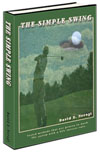 So what are the fundamental swing mechanics we need to be aware of? As a beginner you probably want to start at the beginning which means you want to work on the fundamentals.
So what are the fundamental swing mechanics we need to be aware of? As a beginner you probably want to start at the beginning which means you want to work on the fundamentals.
The fundamentals, as you will hear over and over again, include The Grip, The Set-Up, The Stance and Posture, and certain aspects of The Swing just to name a few. All are important but like all details of learning a complex target motion, they should not be thought of as the final goal. They are all just means to an end and pieces of a complex puzzle.
As time goes on these techniques will become internalized and made automatic. The real goal of the swing is hitting the target and the Essense of the Game is to swing the clubhead through the ball to the target. Learning how that feels is the skill we want to aquire. We can break down that action and focus on specific, left brain techniques and practice those techniques but we should remember that making the ball go to the target is the main focus and ultimate goal.
Any golfer will tell you that they played their best when they have kept technique thoughts to a minimum and focused on target, target, target. In fact people who have played the game in the zone will tell you they were out of their minds and not thinking about much at all. However, we must build this automatic, thoughtless swing from a foundation of fundamental techniques.
What a Beginning Golfer Works On
The things a beginner should work on the range will be far different than what a 5 handicap will work on. All the fundamentals are important but there are certain fundamentals that are more important for a beginner. These include the grip, the waggle, set-up, stance, and take-away. We won’t get into the details of each
As in all learning, you must become accomplished in the basics before you can move to more advanced skills. That’s why it is often difficult for an advanced player to empathize with a beginner because those beginner fundamentals have become so second nature to a good player. They can’t relate to how it feels for a beginner. That’s what makes a great teacher. A great teacher is someone who can put themselves in the pupils golf shoes.
Mastering certain fundamentals will help a beginner get over the initial hump they often feel when first playing the game. Making contact with the ball and getting the ball in the air can seem like climbing a mountain to a beginner. Consistency seems like a dream when one shot goes left, the next way right and the next dribbling on the ground. And of course everyone has experienced the occasional dreaded whiff. Nothing creates tension more than a whiff.
And tension is the problem. Overcoming tension is the key to playing your best golf. No matter what level you are at golf, you must battle it. Even the best golfer, after hitting a bad shot, or facing that crucial putt to win, must stand toe to toe with their inner demons. Part of the lure golf is that it requires direct confrontation with our egos; that part of us that wants to judge every shot, try the improbable, and yet fears failure.
Golf may be the most difficult game of all. The precision required in a difficult golf shot challenges the best athletes in the world, yet anyone is capable of hitting a great shot at any time, and most golfers have. Learning to relax and let yourself hit that great shot is the key and what provides part of the great allure and challenge of golf.
Feel the Clubhead
Everyone talks about The Swing but what is it that we are actually swinging. The key to accurate contact with the ball and a free relaxed motion is realizing that we are really swinging the club head. It helps to remind ourselves again that The Essense of the Game of Golf is swinging the club head through the ball to the target. That image will free our minds and bodies for optimum performance.
As a beginner, we often get hung up on just trying to hit the ball or make solid contact. People may be watcing. Our ego is easily embarrassed and hates to look the fool. It becomes easy to lose sight of The Essence.
Even advanced golfers can lose track of The Essence and begin to play the game of trying to hit the ball right. Trying inevitablly creates tension and leads to more bad shots. Often, after many bad shots in a row, we give up trying and suprisingly hit a great shot. The fact is…trying fails.
Learn to Waggle
So how do we Feel the Clubhead? To begin with we must have a very relaxed grip. Holding the club too tightly will always reduce the sensitivity and feel of our hands. The Waggle is also important. The purpose of The Waggle is to give the brain the feeling of the club head in the hands.
To a beginner, the waggle is a strange proposition. Even to someone familiar with baseball or hockey, a waggle may be a new concept. Golf requres more precision than many sports. In golf the the waggle is critical for sensing where the clubhead is and for applying it precisely to the ball.
The Waggle is also hard to describe to someone who doesn’t have one. Like many things in golf it eventually becomes automatic and you may have no conscious awareness that you are doing it…or how you’re doing it.
The Golf Bible descibes it as the slow, rhythmic, repetitive movement of the clubhead before the shot with the purpose of creating feel. Next time you watch a tournament on TV, observe how each golfer waggles the club. Each may have their own way of doing it but each definitely has one. In addition to grip pressure, how the club is held is important. Almost every great instructor will stress The Grip as perhaps the most important of all fundamentals. As it applies to feeling the clubhead, the key point in grip technique is to hold the club in the fingers, particulaly with the right hand for a right handed person. Many beginners hold the club down in their palms and that prohibits club head feel. Holding the club in the fingers promotes much more feel. Try it and you see.
Find a Swing Trigger
There are some good eBooks for immediate download that offer unique views on golf instruction. Some actually guarantee results. Here’s one that I found that guarantees an improvement of 7-12 strokes on average. Now I haven’t tried this one myself but from my investigations this is the best one on the web. It’s called The Simple Golf Swing and all I can say is just check it out for yourself. If it stinks please let me know and I will be glad to pass that along and take it off the site. It’s guaranteed so what have you got to lose.
results. Here’s one that I found that guarantees an improvement of 7-12 strokes on average. Now I haven’t tried this one myself but from my investigations this is the best one on the web. It’s called The Simple Golf Swing and all I can say is just check it out for yourself. If it stinks please let me know and I will be glad to pass that along and take it off the site. It’s guaranteed so what have you got to lose.
Play Within Yourself
A good training aid will help your game. The good ones either force you to swing in a certain way or give you the “feel” of what a good swing should do. Sometimes the may seem silly but believe me, all the golf pros use and are constantly looking for better tools to help them improve. Go to our training aids page to see some of the current hot training tools.
Hitting Down Makes the Ball Go Up
The only way to convert what we learn from golf books, golf videos, or even one-on-one golf instruction into game improvemnet is to practice what we’re learning. Turning technical “ideas” into actual swing “habits” is a matter of hitting balls and working on our short games and developing a feel for the new techniques.
There is no great golfer who hasn’t put in the time practicing to become a great golfer. Vijay Singh is the poster boy for practice-makes-perfect. All the pros spend hours a day on the practice range. Recreational golfers are lucky to spend hours a month.
It’s also important to know what to practice (that’s where the books and lessons come in) but getting out and doing it is still the key. But how do we really know what to work on. Does a beginner work on the same things that a 5 handicap would work on? Just as clubs for a beginner are different than clubs for an advanced golfer so too are the things they should be working on. Let’s take a look at what each should be working on in terms of techniques and what training aids work for each.

